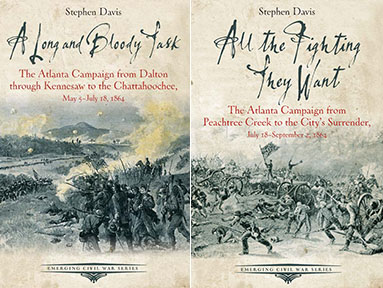The “Emerging Civil War Series” Series: A Long and Bloody Task and All the Fighting They Want
 The Romans had a phrase: Brevitas aurea est, “shortness is golden.”
The Romans had a phrase: Brevitas aurea est, “shortness is golden.”
(Well, they really didn’t, but amo Latinam, so I make these things up as I go along.)
As an Atlanta Campaign guy, I join countless others in esteeming Albert Castel’s Decision in the West (1992) as the go-to source on the subject. Al was a friend, and he thanked me more than once for telling him that the Georgia town was Newnan, not Newman. His book is 665 pages long, befitting its role as reference work (I turn to it almost daily).
But sometimes you want a shorter, quicker read—as Jack Webb used to say on Dragnet, “Just the facts, Ma’am.” Twenty years ago Richard McMurry and I delivered on that line: his Atlanta 1864 (2000) and my Atlanta Will Fall (2001). Neither of us knew that we were working simultaneously!
The Savas Beatie Emerging Civil War series offers something different: concision, affordability and a lot of pictures! The success of the series speaks for itself, as Ted Savas and Chris Mackowski will tell you.
So when I was asked to participate with a monograph on Atlanta, of course I pitched in.
Well, brevitas be damned: my eventual text ran so long that we decided to make it into two books: A Long and Bloody Task (Dalton to the Chattahoochee) and All the Fighting They Want (Peachtree Creek to the surrender).
Aside from concision, what else did we contribute to the literature? First, a lot of cool on-the-site photographs, taken by Dan Davis in a long weekend with me. (Max Van Den Corput’s gravestone at Oakland Cemetery!) In his review of Long and Bloody Task, Robert Jenkins observed that it was Col. Benjamin Harrison’s 70th Indiana that overran Van Den Corput’s battery at Resaca. (it’s nice to get noticed: Bob titled his review, “Marching Through Georgia, Steve Davis Style.”)
With something like 175 images, a book’s captions can also add a lot of material; I told Chris that writing mine was like writing another book.
Johnston’s fall-back tactics have been called Fabian, after the Roman general Quintus Fabius, whose retreats before Hannibal earned him the nickname Cunctator (the Delayer). Mere cunctation is not the usual attribute of great generals, though. Johnston disliked his operations being called “Fabian”; he believed the Roman general against Hannibal had a choice, but against Sherman he didn’t.
Back to the contribution part. One of the chapters I’m happiest about is “Hood Tries to Make Good his Losses.” In it I recount the strenuous measures Hood took to beef up his army after the three attacking battles of late July. He cleared out the hospitals, gave clerks and couriers a musket, and hired slaves to replace soldiers as teamsters. “Return to your colors!’ exclaimed the Columbus Times. (Hood got his friend John Thrasher, head of the Confederate Press Association, to have newspapers spread the word.)
Not to be overlooked is Hal Jespersen’s fine cartography, which alone can tell a story. With “March to the Macon & Western August 30-31” I wanted to show that Schofield’s XXIII Corps reached the railroad eight miles north of Jonesboro at 3 p.m. on the 31st, just as Hardee and Lee launched their assault against Howard’s army. In other words, the Confederate attack at Jonesboro really didn’t matter; Hood knew that the M & W had been cut even before he learned of Hardee’s repulse. (Continued focus on that inconsequential battle is a phenomenon I call “Jonesboropia.”)
Finally, there is Emerging Civil War’s emphasis on readability. I dedicated my second volume
To the late great Bell Irvin Wiley (1906-1980)
who taught me that writing clearly about
what you know is just as important as
knowing it in the first place.
————
A Long and Bloody Task: The Atlanta Campaign from Dalton through Kennesaw Mountain to the Chattahoochee River, May 5-July 18, 1864
by Stephen Davis
Savas Beatie, 2016
Click here to read more about the book, including a book description, reviews, and an author bio.
Click here for ordering information.
Click here for the audiobook, read by Gary Williams.
All the Fighting They Want: The Atlanta Campaign from Peachtree Creek to the City’s Surrender, July 18-September 2, 1864
by Stephen Davis
Savas Beatie, 2017
Click here to read more about the book, including a book description, reviews, and an author bio.

2 Responses to The “Emerging Civil War Series” Series: A Long and Bloody Task and All the Fighting They Want